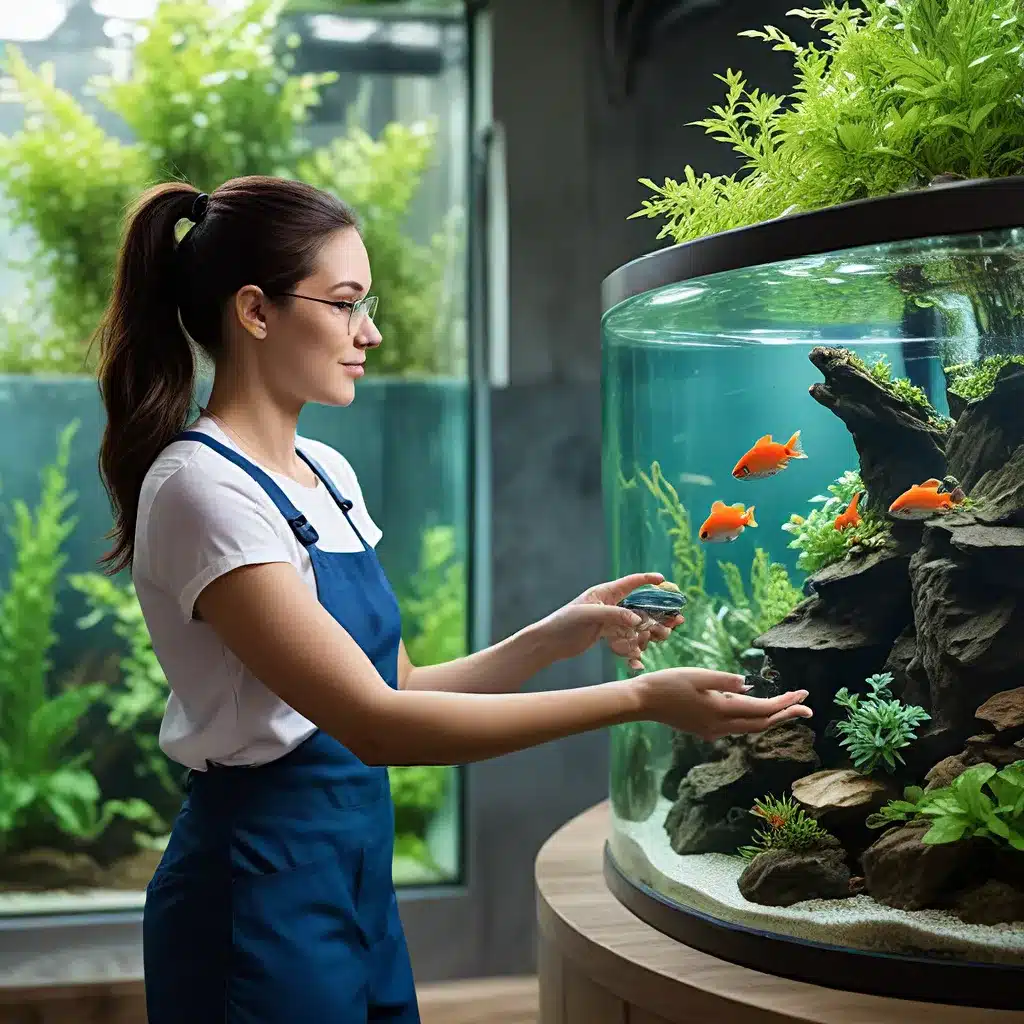
In the captivating world of aquarium keeping, the delicate balance between aesthetics, species health, and environmental sustainability is a constant pursuit. As aquarists and enthusiasts, we are tasked with creating vibrant, thriving ecosystems that not only delight the eye but also nurture the aquatic life within. This article delves into the transformative power of sustainable aquarium practices, guiding you through the alchemy of aquascaping, water management, and species-specific care.
Aquascaping: The Art of Aquatic Landscapes
Aquascaping, the art of designing and arranging aquatic plants, rocks, and décor, is a crucial aspect of creating a visually stunning and ecologically balanced aquarium. By thoughtfully curating the underwater landscape, aquarists can not only enhance the aesthetic appeal of their tanks but also foster an environment that supports the diverse needs of the inhabitants.
One key principle of sustainable aquascaping is the careful selection of plant species. Choosing hardy, low-maintenance plants that thrive in the given aquarium conditions is essential. Native or well-adapted species not only add visual interest but also contribute to the natural balance of the ecosystem, helping to maintain water quality and provide crucial oxygen production. King Aquarium offers a wide range of aquatic plants carefully selected for their compatibility and suitability for various tank setups.
Another critical aspect of sustainable aquascaping is the incorporation of natural rock formations and driftwood. These elements not only enhance the aesthetic appeal of the aquarium but also serve as important hiding spots and spawning grounds for fish, as well as providing substrate for beneficial bacterial growth. By selecting materials that are inert and safe for aquatic life, aquarists can ensure the long-term health and stability of their aquarium ecosystems.
Mastering Water Management
Maintaining optimal water quality is the foundation of a thriving, sustainable aquarium. Proper water management involves a delicate balance of chemical parameters, filtration systems, and routine maintenance.
Nutrient cycling is a crucial consideration in water management. Aquarists must ensure that the right balance of nutrients, such as nitrogen, phosphorus, and carbon, is maintained to support healthy plant growth and minimize the buildup of harmful waste products. Incorporating live plants, effective filtration, and regular water changes can help to maintain this balance and create a stable, nutrient-rich environment.
Filtration systems play a vital role in water quality management. Choosing the right type of filtration, whether it be mechanical, biological, or chemical, can significantly impact the overall health of the aquarium. Aquarists should research and select filtration solutions that are tailored to the specific needs of their aquarium inhabitants, water volume, and aquascaping design.
In addition to filtration, routine water testing and maintenance are essential for sustainable aquarium keeping. Regularly monitoring parameters such as pH, temperature, and dissolved oxygen levels, and making timely adjustments, can help to prevent water quality issues and ensure the long-term well-being of the aquatic ecosystem.
Species-Specific Care: Tailoring Your Approach
Aquarium success relies on understanding the unique needs and requirements of the specific fish, plants, and invertebrates housed within. By adopting a species-specific approach to care, aquarists can create thriving, harmonious communities that showcase the natural beauty of aquatic life.
Fish selection is a critical aspect of sustainable aquarium keeping. Choosing fish that are compatible in terms of size, temperament, and water parameter requirements can help to minimize stress and promote overall well-being. Researching the specific needs of each species, such as their preferred water pH, temperature, and tank size, can guide aquarists in creating an environment that caters to the unique needs of their inhabitants.
Aquatic plant care is equally important, as the health and growth of plants directly impact water quality and the overall aesthetics of the aquarium. Understanding the specific lighting, nutrient, and substrate requirements of different plant species can help aquarists cultivate a lush, vibrant underwater landscape that supports the entire ecosystem.
Finally, the incorporation of invertebrates, such as shrimp, snails, or beneficial bacteria, can play a crucial role in maintaining a balanced and sustainable aquarium. These organisms can help to break down organic matter, regulate nutrient levels, and contribute to the overall biological stability of the system.
By tailoring their approach to the specific needs of the aquarium inhabitants, aquarists can create thriving, low-maintenance ecosystems that showcase the beauty and wonder of the underwater world.
The Rewards of Sustainable Aquarium Keeping
Embracing sustainable aquarium practices not only benefits the health and well-being of the aquatic life within but also offers a multitude of rewards for aquarists themselves. From the visual delight of a thriving, natural-looking aquarium to the sense of accomplishment in maintaining a balanced ecosystem, the journey of sustainable aquarium keeping is truly one of alchemy and wonder.
Aesthetic Appeal: A well-designed, sustainably maintained aquarium can be a true work of art, captivating the senses and creating a calming, mesmerizing focal point in any living space. The harmonious integration of plants, décor, and aquatic life breathes life into the underwater landscape, evoking a sense of tranquility and natural beauty.
Environmental Responsibility: By embracing sustainable aquarium practices, aquarists can contribute to the preservation of aquatic ecosystems, both in the captive and natural environments. Through responsible resource management, thoughtful species selection, and the promotion of healthy, balanced aquariums, aquarists can play a vital role in conservation efforts and inspire others to adopt eco-friendly practices.
Long-Term Stability: Sustainable aquarium keeping requires a deeper understanding of the complex interplay between water chemistry, biological processes, and the specific needs of aquatic inhabitants. By mastering these principles, aquarists can create aquarium environments that are inherently stable and resilient, reducing the need for frequent interventions and ensuring the long-term well-being of the aquatic life within.
As you embark on your journey of aquarium alchemy, remember that the path to sustainable success is paved with patience, dedication, and a deep appreciation for the natural world. By unlocking the secrets of sustainable aquarium practices, you’ll not only cultivate a vibrant, thriving ecosystem but also contribute to the preservation of aquatic life and inspire others to join you in this captivating pursuit.

